2022 HYUNDAI IONIQ ELECTRIC brake
[x] Cancel search: brakePage 339 of 546
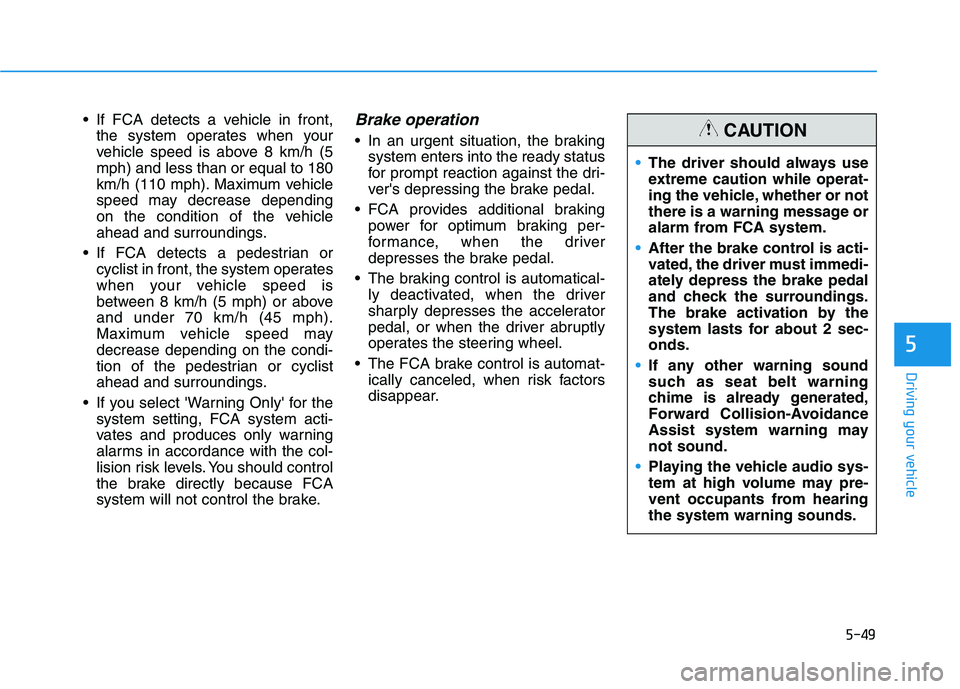
5-49
Driving your vehicle
5
If FCA detects a vehicle in front,the system operates when your
vehicle speed is above 8 km/h (5mph) and less than or equal to 180
km/h (110 mph). Maximum vehicle
speed may decrease depending
on the condition of the vehicle
ahead and surroundings.
If FCA detects a pedestrian or cyclist in front, the system operates
when your vehicle speed is
between 8 km/h (5 mph) or aboveand under 70 km/h (45 mph).
Maximum vehicle speed maydecrease depending on the condi-
tion of the pedestrian or cyclist
ahead and surroundings.
If you select 'Warning Only' for the system setting, FCA system acti-
vates and produces only warning
alarms in accordance with the col-
lision risk levels. You should control
the brake directly because FCA
system will not control the brake.Brake operation
In an urgent situation, the brakingsystem enters into the ready status
for prompt reaction against the dri-
ver's depressing the brake pedal.
FCA provides additional braking power for optimum braking per-
formance, when the driver
depresses the brake pedal.
The braking control is automatical- ly deactivated, when the driver
sharply depresses the accelerator
pedal, or when the driver abruptly
operates the steering wheel.
The FCA brake control is automat- ically canceled, when risk factors
disappear.
The driver should always use
extreme caution while operat-
ing the vehicle, whether or not
there is a warning message or
alarm from FCA system.
After the brake control is acti-
vated, the driver must immedi-
ately depress the brake pedal
and check the surroundings.
The brake activation by the
system lasts for about 2 sec-onds.
If any other warning sound
such as seat belt warning
chime is already generated,
Forward Collision-Avoidance
Assist system warning maynot sound.
Playing the vehicle audio sys-
tem at high volume may pre-
vent occupants from hearingthe system warning sounds.
CAUTION
Page 343 of 546

5-53
Driving your vehicle
5
FCA is only a supplemental
system for the driver's con-
venience. The driver shouldhold the responsibility to con-
trol the vehicle operation. Do
not solely depend on FCA
system. Rather, maintain a
safe braking distance, and, if
necessary, depress the brakepedal to reduce the driving
speed or to stop the vehicle.
In certain instances and
under certain driving condi-
tions, FCA system may acti-
vate unintentionally. This ini-
tial warning message appears
on the LCD display with a
warning chime. Also due to sensing limita-
tions, in certain situations, the
front radar sensor or front viewcamera recognition system
may not detect the vehicle,
pedestrian or cyclist ahead.
FCA system may not activate
and the warning message may
not be displayed.(Continued)
(Continued)
Even if there is any problem
with the brake control func-
tion of FCA system, the vehi-
cle's basic braking perform-
ance will operate normally.
However, brake control func-
tion for avoiding collision will
not activate.
If the vehicle in front stops
suddenly, you may have less
control of the brake system.
Therefore, always keep a safe
distance between your vehicle
and the vehicle in front of you.
FCA system may activate dur-
ing braking and the vehicle
may stop suddenly shifting
loose objects toward the pas-
sengers. Always keep looseobjects secured.
FCA system may not activate if the driver applies the brake
pedal to avoid collision.
(Continued)
WARNING (Continued)
If a vehicle in front abruptly
stops, the brake control may
not work possibly causing acollision.
Occupants may get injured, if
the vehicle abruptly stops by
the activated FCA system. Pay
extreme caution.
FCA system operates only when the system detects vehi-
cles, pedestrian, or cyclist
directly in front of the vehicle.
Page 344 of 546
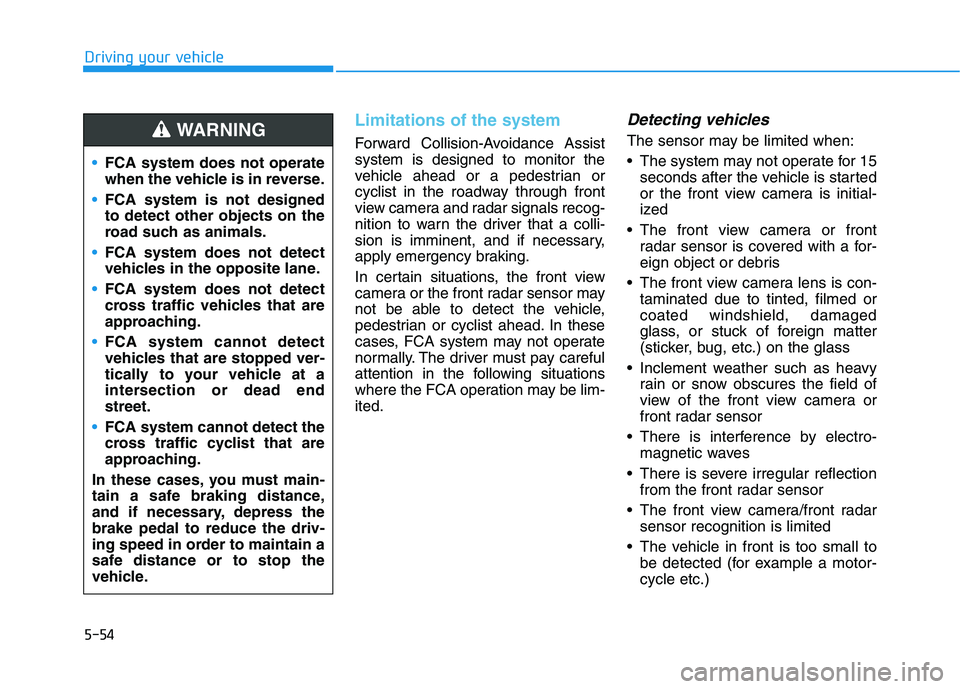
5-54
Driving your vehicle
Limitations of the system
Forward Collision-Avoidance Assist system is designed to monitor the
vehicle ahead or a pedestrian or
cyclist in the roadway through front
view camera and radar signals recog-
nition to warn the driver that a colli-
sion is imminent, and if necessary,
apply emergency braking.
In certain situations, the front view
camera or the front radar sensor may
not be able to detect the vehicle,
pedestrian or cyclist ahead. In these
cases, FCA system may not operate
normally. The driver must pay careful
attention in the following situations
where the FCA operation may be lim-ited.
Detecting vehicles
The sensor may be limited when:
The system may not operate for 15seconds after the vehicle is started
or the front view camera is initial-
ized
The front view camera or front radar sensor is covered with a for-
eign object or debris
The front view camera lens is con- taminated due to tinted, filmed orcoated windshield, damaged
glass, or stuck of foreign matter
(sticker, bug, etc.) on the glass
Inclement weather such as heavy rain or snow obscures the field of
view of the front view camera or
front radar sensor
There is interference by electro- magnetic waves
There is severe irregular reflection from the front radar sensor
The front view camera/front radar sensor recognition is limited
The vehicle in front is too small to be detected (for example a motor-cycle etc.)
FCA system does not operate
when the vehicle is in reverse.
FCA system is not designed to detect other objects on the
road such as animals.
FCA system does not detect
vehicles in the opposite lane.
FCA system does not detect
cross traffic vehicles that are
approaching.
FCA system cannot detect
vehicles that are stopped ver-
tically to your vehicle at a
intersection or dead endstreet.
FCA system cannot detect the
cross traffic cyclist that are
approaching.
In these cases, you must main-
tain a safe braking distance,
and if necessary, depress thebrake pedal to reduce the driv-
ing speed in order to maintain a
safe distance or to stop the
vehicle.
WARNING
Page 346 of 546
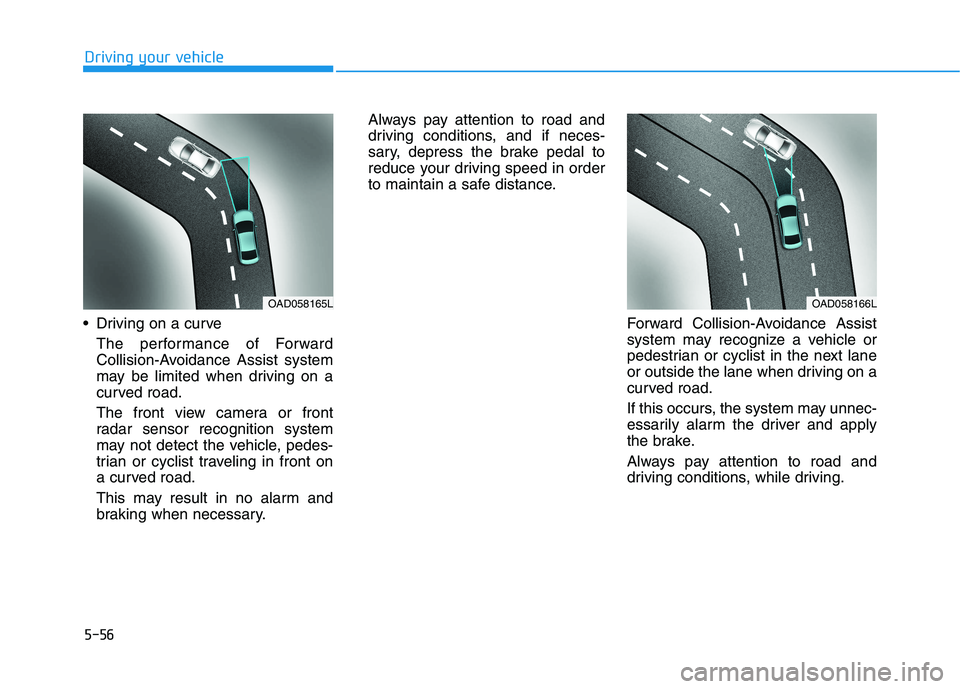
5-56
Driving your vehicle
Driving on a curveThe performance of Forward
Collision-Avoidance Assist system
may be limited when driving on a
curved road.
The front view camera or front
radar sensor recognition system
may not detect the vehicle, pedes-
trian or cyclist traveling in front on
a curved road.
This may result in no alarm and
braking when necessary. Always pay attention to road and
driving conditions, and if neces-
sary, depress the brake pedal to
reduce your driving speed in order
to maintain a safe distance.
Forward Collision-Avoidance Assist
system may recognize a vehicle or
pedestrian or cyclist in the next lane
or outside the lane when driving on a
curved road.
If this occurs, the system may unnec-
essarily alarm the driver and apply
the brake.
Always pay attention to road and
driving conditions, while driving.
OAD058165LOAD058166L
Page 347 of 546
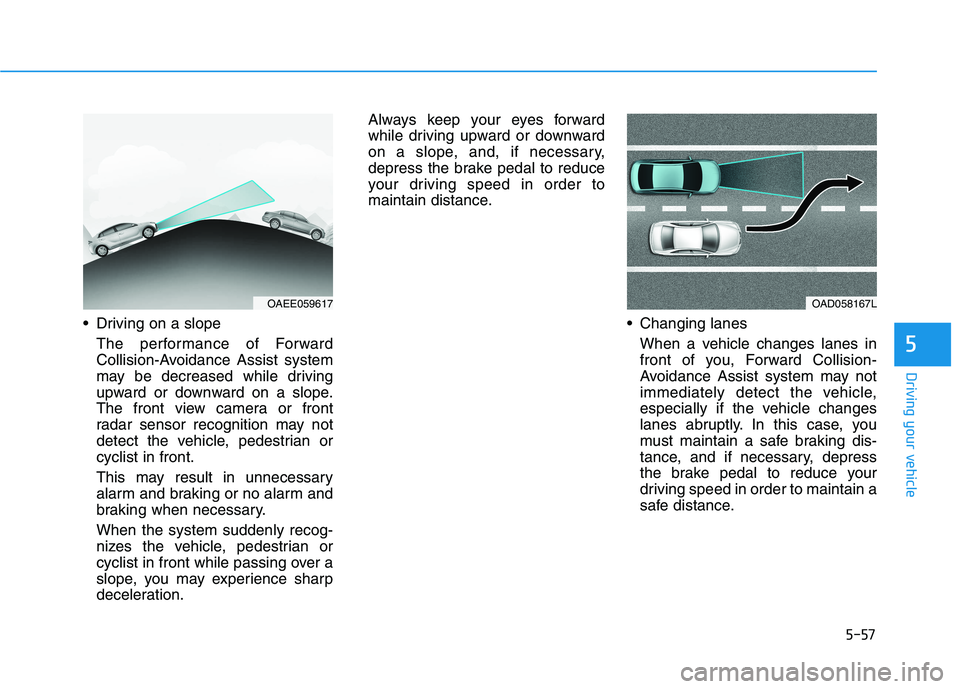
5-57
Driving your vehicle
5
Driving on a slopeThe performance of Forward
Collision-Avoidance Assist system
may be decreased while driving
upward or downward on a slope.
The front view camera or front
radar sensor recognition may not
detect the vehicle, pedestrian orcyclist in front.
This may result in unnecessary
alarm and braking or no alarm and
braking when necessary. When the system suddenly recog-
nizes the vehicle, pedestrian or
cyclist in front while passing over a
slope, you may experience sharp
deceleration. Always keep your eyes forward
while driving upward or downward
on a slope, and, if necessary,
depress the brake pedal to reduce
your driving speed in order to
maintain distance.
Changing lanesWhen a vehicle changes lanes in
front of you, Forward Collision-
Avoidance Assist system may not
immediately detect the vehicle,
especially if the vehicle changes
lanes abruptly. In this case, you
must maintain a safe braking dis-
tance, and if necessary, depress
the brake pedal to reduce your
driving speed in order to maintain a
safe distance.
OAEE059617OAD058167L
Page 348 of 546

5-58
Driving your vehicle
When driving in stop-and-go traffic,
and a vehicle in front of you merges
out of the lane, the Forward Collision-
Avoidance Assist system may not
immediately detect the new vehicle
that is now in front of you. In this case,
you must maintain a safe braking dis-
tance, and if necessary, depress the
brake pedal to reduce your driving
speed in order to maintain a safe dis-
tance. Detecting the vehicle in front of you
If the vehicle in front of you has
cargo that extends rearward from
the cab, or when the vehicle in
front of you has higher ground
clearance, additional special atten-
tion is required. Forward Collision-
Avoidance Assist system may not
be able to detect the cargo extend-
ing from the vehicle. In these
instances, you must maintain a
safe braking distance from the
rearmost object, and if necessary,
depress the brake pedal to reduce
your driving speed in order to
maintain distance.
Detecting pedestrians orcyclists
The sensor may be limited when:
The pedestrian or cyclist is not fully detected by the front view camera
recognition system, for example, if
the pedestrian is leaning over or is
not fully walking upright
The pedestrian or cyclist is moving very quickly or appears abruptly in
the front view camera detectionarea
The pedestrian or cyclist is wear- ing clothing that easily blends into
the background, making it difficult
to be detected by the front view
camera recognition system
The outside lighting is too bright (e.g. when driving in bright sunlight
or in sun glare) or too dark (e.g.
when driving on a dark rural roadat night)
It is difficult to detect and distin- guish the pedestrian or cyclist from
other objects in the surroundings,
for example, when there is a group
of pedestrians, cyclists or a large
crowd
OAD058168LOAEE059620
Page 357 of 546
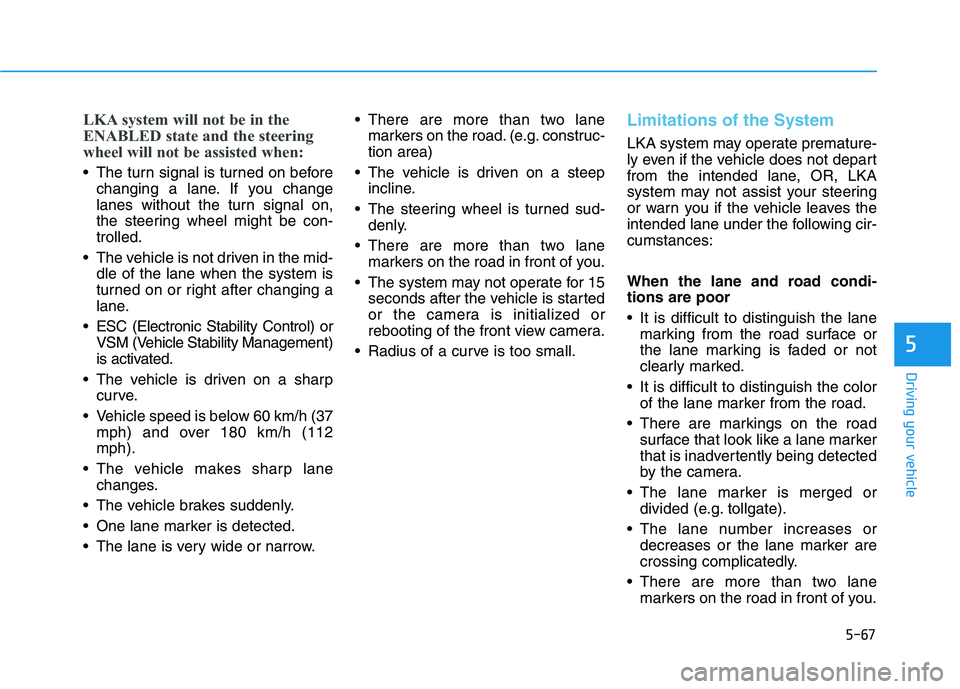
5-67
Driving your vehicle
5
LKA system will not be in the
ENABLED state and the steering
wheel will not be assisted when:
The turn signal is turned on beforechanging a lane. If you change
lanes without the turn signal on,
the steering wheel might be con-trolled.
The vehicle is not driven in the mid- dle of the lane when the system is
turned on or right after changing a
lane.
ESC (Electronic Stability Control) or VSM (Vehicle Stability Management)
is activated.
The vehicle is driven on a sharp curve.
Vehicle speed is below 60 km/h (37 mph) and over 180 km/h (112mph).
The vehicle makes sharp lane changes.
The vehicle brakes suddenly.
One lane marker is detected.
The lane is very wide or narrow. There are more than two lane
markers on the road. (e.g. construc- tion area)
The vehicle is driven on a steep incline.
The steering wheel is turned sud- denly.
There are more than two lane markers on the road in front of you.
The system may not operate for 15 seconds after the vehicle is started
or the camera is initialized or
rebooting of the front view camera.
Radius of a curve is too small.
Limitations of the System
LKA system may operate premature-
ly even if the vehicle does not depart
from the intended lane, OR, LKA
system may not assist your steering
or warn you if the vehicle leaves the
intended lane under the following cir-cumstances:
When the lane and road condi- tions are poor
It is difficult to distinguish the lane marking from the road surface or
the lane marking is faded or not
clearly marked.
It is difficult to distinguish the color of the lane marker from the road.
There are markings on the road surface that look like a lane marker
that is inadvertently being detected
by the camera.
The lane marker is merged or divided (e.g. tollgate).
The lane number increases or decreases or the lane marker are
crossing complicatedly.
There are more than two lane markers on the road in front of you.
Page 381 of 546
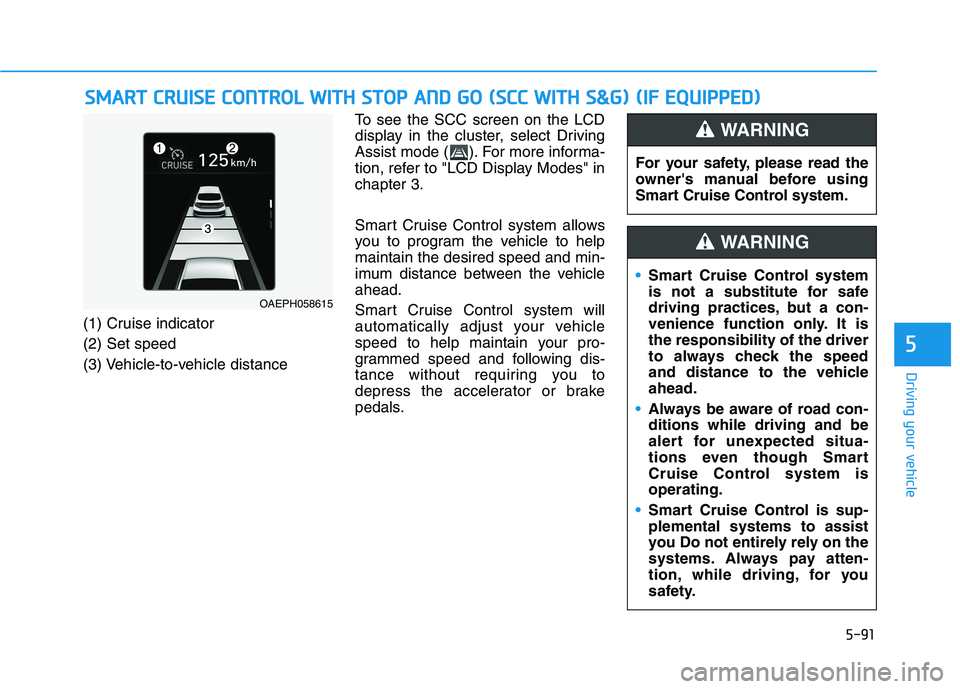
5-91
Driving your vehicle
5
SSMM AARRTT CC RR UU IISS EE CC OO NNTTRR OO LL WW IITT HH SS TT OO PP AA NN DD GG OO (( SS CC CC WW IITT HH SS && GG)) (( IIFF EE QQ UUIIPP PPEEDD ))
(1) Cruise indicator (2) Set speed
(3) Vehicle-to-vehicle distance To see the SCC screen on the LCD
display in the cluster, select Driving
Assist mode ( ). For more informa-
tion, refer to "LCD Display Modes" inchapter 3.
Smart Cruise Control system allows
you to program the vehicle to helpmaintain the desired speed and min-
imum distance between the vehicleahead.
Smart Cruise Control system will
automatically adjust your vehicle
speed to help maintain your pro-
grammed speed and following dis-
tance without requiring you to
depress the accelerator or brake
pedals.
OAEPH058615
For your safety, please read the
owner's manual before using
Smart Cruise Control system.
WARNING
Smart Cruise Control system
is not a substitute for safe
driving practices, but a con-
venience function only. It isthe responsibility of the driver
to always check the speed
and distance to the vehicleahead.
Always be aware of road con- ditions while driving and be
alert for unexpected situa-
tions even though Smart
Cruise Control system isoperating.
Smart Cruise Control is sup- plemental systems to assist
you Do not entirely rely on the
systems. Always pay atten-
tion, while driving, for you
safety.
WARNING